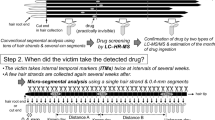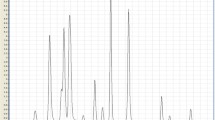Abstract
Purpose
Hair can be the only available specimen to prove drug-facilitated crimes (DFCs). However, it is difficult to identify drugs abused in DFCs, particularly benzodiazepines ingested in a single dose, using the conventional segmental hair analysis. In this study, an analytical procedure to identify a trace amount of drug in hair based on micro-segmental analysis was developed.
Methods
Hair was donated from a subject who had been administered midazolam in a single dose. First, tens of hair strands were analyzed according to our routine procedure. Drug screening and identification were performed using a quadrupole-Orbitrap liquid chromatography–tandem mass spectrometry (LC–MS/MS) instrument. Next, two hair strands were segmented at 0.4-mm intervals and multi-target selected reaction monitoring of each segment (micro-segmental analysis) was performed using a tandem quadrupole LC–MS/MS instrument. After distribution curves of midazolam-derived ions in each hair strand were constructed, the residual extracts from segments corresponding to drug-containing regions were collected selectively into one tube. The extract was concentrated using solid-phase extraction and then injected into the LC–MS/MS instrument for drug identification.
Results
We failed to identify drugs using our routine procedure, although a slight peak, predicted to arise from midazolam, was detected, while the peak detected in the concentrated extract from drug-containing hair regions (named “selective concentration”) was identified as midazolam.
Conclusions
The “selective concentration” enabled the identification of a trace amount of drug using several hair strands. The method would be helpful in proving DFCs even after it was impossible to identify drugs using conventional segmental hair analysis.





Similar content being viewed by others
References
Chèze M, Duffort G, Deveaux M, Pépin G (2005) Hair analysis by liquid chromatography-tandem mass spectrometry in toxicological investigation of drug-facilitated crimes: report of 128 cases over the period June 2003-May 2004 in metropolitan Paris. Forensic Sci Int 153:3–10. https://doi.org/10.1016/j.forsciint.2005.04.021
Lee S, Han E, In S, Choi H, Chung H, Chung KH (2011) Determination of illegally abused sedative-hypnotics in hair samples from drug offenders. J Anal Toxicol 35:312–315. https://doi.org/10.1093/anatox/35.5.312
Rust KY, Baumgartner MR, Meggiolaro N, Kraemer T (2012) Detection and validated quantification of 21 benzodiazepines and 3 “z-drugs” in human hair by LC-MS/MS. Forensic Sci Int 215:64–72. https://doi.org/10.1016/j.forsciint.2011.07.052
Irving RC, Dickson SJ (2007) The detection of sedatives in hair and nail samples using tandem LC-MS-MS. Forensic Sci Int 166:58–67. https://doi.org/10.1016/j.forsciint.2006.03.027
Villain M, Concheiro M, Cirimele V, Kintz P (2005) Screening method for benzodiazepines and hypnotics in hair at pg/mg level by liquid chromatography-mass spectrometry/mass spectrometry. J Chromatogr B Analyt Technol Biomed Life Sci 825:72–78. https://doi.org/10.1016/j.jchromb.2004.12.036
Kuwayama K, Miyaguchi H, Iwata YT, Kanamori T, Tsujikawa K, Yamamuro T, Segawa H, Inoue H (2019) Strong evidence of drug-facilitated crimes by hair analysis using LC–MS/MS after micro-segmentation. Forensic Toxicol 37:480–487. https://doi.org/10.1007/s11419-019-00472-3
Drugs.com, https://www.drugs.com. Accessed 20 Jul 2020
Kamata T, Shima N, Sasaki K, Matsuta S, Takei S, Katagi M, Miki A, Zaitsu K, Nakanishi T, Sato T, Suzuki K, Tsuchihashi H (2015) Time-course mass spectrometry imaging for depicting drug incorporation into hair. Anal Chem 87:5476–5481. https://doi.org/10.1021/acs.analchem.5b00971
Shima N, Sasaki K, Kamata T, Matsuta S, Wada M, Kakehashi H, Nakano S, Kamata H, Nishioka H, Sato T, Tsuchihashi H, Miki A, Katagi M (2017) Incorporation of zolpidem into hair and its distribution after a single administration. Drug Metab Dispos 45:286–293. https://doi.org/10.1124/dmd.116.074211
Kuwayama K, Miyaguchi H, Iwata YT, Kanamori T, Tsujikawa K, Yamamuro T, Segawa H, Inoue H (2018) Different localizations of drugs simultaneously administered in a strand of hair by micro-segmental analysis. Drug Test Anal 10:750–760. https://doi.org/10.1002/dta.2259
Kintz P, Salomone A, Vincenti M (2015) Hair analysis in clinical and forensic toxicology. Academic Press, Cambridge
Kuwayama K, Miyaguchi H, Iwata YT, Kanamori T, Tsujikawa K, Yamamuro T, Segawa H, Inoue H (2016) Three-step drug extraction from a single sub-millimeter segment of hair and nail to determine the exact day of drug intake. Anal Chim Acta 948:40–47. https://doi.org/10.1016/j.aca.2016.10.029
Kuwayama K, Nariai M, Miyaguchi H, Iwata YT, Kanamori T, Tsujikawa K, Yamamuro T, Segawa H, Abe H, Iwase H, Inoue H (2018) Accurate estimation of drug intake day by micro-segmental analysis of a strand of hair using internal temporal markers. J Appl Lab Med 3:37–47. https://doi.org/10.1373/jalm.2017.025346
Kuwayama K, Nariai M, Miyaguchi H, Iwata YT, Kanamori T, Tsujikawa K, Yamamuro T, Segawa H, Abe H, Iwase H, Inoue H (2018) Micro-segmental hair analysis for proving drug-facilitated crimes: evidence that a victim ingested a sleeping aid, diphenhydramine, on a specific day. Forensic Sci Int 288:23–28. https://doi.org/10.1016/j.forsciint.2018.04.027
Colucci AP, Gagliano-Candela R, Aventaggiato L, De Donno A, Leonardi S, Strisciullo G, Introna F (2013) Suicide by self-administration of a drug mixture (propofol, midazolam, and zolpidem) in an anesthesiologist: the first case report in Italy. J Forensic Sci 58:837–841. https://doi.org/10.1111/1556-4029.12053
Kintz P, Villain M, Dumestre V, Cirimele V (2005) Evidence of addiction by anesthesiologists as documented by hair analysis. Forensic Sci Int 153:81–84. https://doi.org/10.1016/j.forsciint.2005.04.033
Cirimele V, Kintz P, Doray S, Ludes B (2002) Determination of chronic abuse of the anaesthetic agents midazolam and propofol as demonstrated by hair analysis. Int J Legal Med 116:54–57. https://doi.org/10.1007/s004140100240
Scientific Working Group for Forensic Toxicology (2013) Scientific Working Group for Forensic Toxicology (SWGTOX) standard practices for method validation in forensic toxicology. J Anal Toxicol 37:452–474. https://doi.org/10.1093/jat/bkt054
Waters Corporation, Oasis Solid-Phase Extraction Products, https://www.waters.com/webassets/cms/library/docs/720001692en.pdf. Accessed 28 June 2020
World Anti-Doping Agency Laboratory Expert Group (2015) WADA technical document—TD2015IDCR: minimum criteria for chromatographic-mass spectrometric confirmation of the identity of analytes for doping control purposes. WADA, Montreal
Narciso J, Luz S, Bettencourt da Silva R (2019) Assessment of the quality of doping substances identification in urine by GC/MS/MS. Anal Chem 91:6638–6644. https://doi.org/10.1021/acs.analchem.9b00560
SOFT/AAFS Forensic Laboratory Guidelines 2006 Version (2006) http://www.soft-tox.org/files/Guidelines_2006_Final.pdf. Accessed 28 June 2020
Elliott SP, Stephen DWS, Paterson S (2018) The United Kingdom and Ireland association of forensic toxicologists forensic toxicology laboratory guidelines (2018). Sci Justice 58:335–345. https://doi.org/10.1016/j.scijus.2018.05.004
Kahl KW, Seither JZ, Reidy LJ (2019) LC-MS-MS vs ELISA: validation of a comprehensive urine toxicology screen by LC-MS-MS and a comparison of 100 forensic specimens. J Anal Toxicol 43:734–745. https://doi.org/10.1093/jat/bkz066
Perez ER, Knapp JA, Horn CK, Stillman SL, Evans JE, Arfsten DP (2016) Comparison of LC-MS-MS and GC-MS analysis of benzodiazepine compounds included in the drug demand reduction urinalysis program. J Anal Toxicol 40:201–207. https://doi.org/10.1093/jat/bkv140
Miyaguchi H (2014) Determination of sedative–hypnotics in human hair by micropulverized extraction and liquid chromatography/quadrupole-Orbitrap mass spectrometry. Anal Methods 6:5777–5783. https://doi.org/10.1039/C4AY00505H
Morini L, Vignali C, Polla M, Sponta A, Groppi A (2012) Comparison of extraction procedures for benzodiazepines determination in hair by LC-MS/MS. Forensic Sci Int 218:53–56. https://doi.org/10.1016/j.forsciint.2011.10.013
Madry MM, Kraemer T, Baumgartner MR (2018) Systematic assessment of different solvents for the extraction of drugs of abuse and pharmaceuticals from an authentic hair pool. Forensic Sci Int 282:137–143. https://doi.org/10.1016/j.forsciint.2017.11.027
Khelfi A, Azzouz M, Abtroun R, Reggabi M, Alamir B (2018) Determination of chlorpromazine, haloperidol, levomepromazine, olanzapine, risperidone, and sulpiride in human plasma by liquid chromatography/tandem mass spectrometry (LC-MS/MS). Int J Anal Chem 2018:5807218. https://doi.org/10.1155/2018/5807218
Pérez-Alcaraz A, Borrull F, Aguilar C, Calull M (2019) Enantioselective determination of cathinones in urine by high pressure in-line SPE-CE. Electrophoresis 40:1762–1770. https://doi.org/10.1002/elps.201900072
Castilla-Fernández D, Moreno-González D, Beneito-Cambra M, Molina-Díaz A (2019) Critical assessment of two sample treatment methods for multiresidue determination of veterinary drugs in milk by UHPLC-MS/MS. Anal Bioanal Chem 411:1433–1442. https://doi.org/10.1007/s00216-019-01582-y
Kuwayama K, Nariai M, Miyaguchi H, Iwata YT, Kanamori T, Tsujikawa K, Yamamuro T, Segawa H, Abe H, Iwase H, Inoue H (2019) Estimation of day of death using micro-segmental hair analysis based on drug use history: a case of lidocaine use as a marker. Int J Legal Med 133:117–122. https://doi.org/10.1007/s00414-018-1939-9
Acknowledgements
This work was supported by JSPS KAKENHI grant number 19K10700.
Author information
Authors and Affiliations
Corresponding author
Ethics declarations
Conflict of interest
The authors declare that they have no conflict of interest.
Ethical approval
All procedures performed in studies involving human participants were in accordance with the ethical standards of the institutional and/or national research committee at the National Research Institute of Police Science (Approval No. 2019005, Kashiwa, Japan) and with the 1964 Helsinki declaration and its later amendments or comparable ethical standards.
Informed consent
Informed consent was obtained from all individual participants included in the study.
Additional information
Publisher's Note
Springer Nature remains neutral with regard to jurisdictional claims in published maps and institutional affiliations.
Electronic supplementary material
Below is the link to the electronic supplementary material.
Rights and permissions
About this article
Cite this article
Kuwayama, K., Miyaguchi, H., Kanamori, T. et al. Development of the “selective concentration” analytical method for drug-containing hair regions based on micro-segmental analysis to identify a trace amount of drug in hair: hair analysis following single-dose ingestion of midazolam. Forensic Toxicol 39, 156–166 (2021). https://doi.org/10.1007/s11419-020-00553-8
Received:
Accepted:
Published:
Issue Date:
DOI: https://doi.org/10.1007/s11419-020-00553-8




